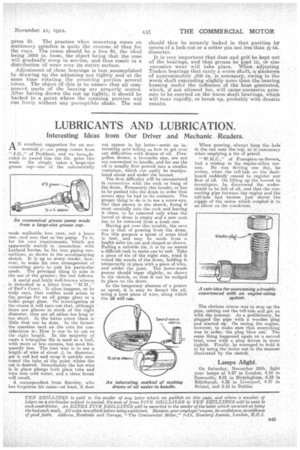LUBRICANTS AND , LUBRICATION.
Page 29

If you've noticed an error in this article please click here to report it so we can fix it.
Interesting Ideas from Our Driver and Mechanic ,Readers.
AN excellent suggestion for an eco
nomiCal pump comes from " of Peckham, and we have.de cided to award him the 15s. prize this week. He simply takes a large-size grease cup—one of the substantially made malleable iron ones, not a brass
one nod uses that as the pqmp. To it, for his own requirements, -Which are apparently mainly in connection with Leyland lorries, he -fits iron piping connections, as shown in the accompanying sketch. It is up to every reader, however, to make his own arrangement of connecting parts to suit his particular needs. The principal thing to note is the use of the greaser; the rest follows.
A useful and fairly well-known wheeze is embodied in a letter from "
or Earl's Court. It often happens, as he truly says, that sudden need arises in the garage for an oil gauge glass or a boiler gauge glass. On investigation of the stores it will turn out that, although there are glasses in stock of the right diameter, they are all either too long or too short, In the latter event there is little that can be done. In the former the question next on the rota for consideration is How is one to be cut to the right length. In the majority of cases a triangular file is used as a tool, with more or less. success, but most frequently less. The best way is to use a length of wire of about -1in. diameter, get it red hot and wrap it quickly once round the tube at the point where the cut is desired. Immediately the hot wire is in place plunge both glass tube and wire into cold water, and a clean break will result.
A correspondent from Burnley, who has forgotten his name—at least, it does not appear in his letter—sends an interesting note telling us how to get over our difficulties with drums of oil. Fivegallon drums, a favourite size, are not too convenient to handle, and for use the oil is usually first poured into a smaller container, which can easily be manipulated about and under the bonnet.
The first difficulty will be encountered in connection with the cork or bung of the drum. Frequently this breaks, or has to be pushed into the drum in order that access may be had to its contents. The proper thing to do is to use a screw-eye, like that shown in the sketch, fixing it most carefully into the cork and leaving it there, to be removed only when the barrel or drum is empty and a new cork has to be removed from a fresh one.
Having got over this trouble, the next one is that of pouring froin.the drum. For this purpose a spout of some kind is best, and may be made from a health salts tin cut and shaped as shown. Failing a suitable tin, it is by no. means' a difficult task to make one to suit. Take a piece of tin of the right size, wind it round the nozzle of the drum, holding it temporarily in place with a piece of wire, and solder the joint. The home-made pourer should taper slightly, as shown in the sketch, so that it can be wedged in place on the drum.
In the temporary absence of a pourer or spout, it is easy to decant the oil, -Using a bent piece of wire, along which the oil wil run.
When pouring, always keep the hole in the can near the top, as is customary when emptying a tin of petrol.
" W.M.C.," of Frampton-on-Severn, had a mishap to his engine-oiling system. Ho was driving one day, he writes, when the tell-tale on the dashboard suddenly ceased to register any flow of MI. On lifting up the bonnet to investigate, he discovered the undershield to he full of oil, and that the connecting pipe between the engine and the tell-tale had broken just above the nipple of the union which coupled it to an elbow on the crankcase.
The obvious course was to stop up the pipe, cutting out the tell-tale and get on with the journey. As a preliminary., he plugged the pipe with a wooden plug and started up. On racing the engine, however, to make sure that everything was in order, the plug blew out. The same thing happened again on a second trial, even with a plug driven in more tightly. Finally, he managed to hold it in by using the union nut in the manner illustrated by the sketch.
Lamps Alight, On Saturday, November 25th, light your lamps at 4.27 in London, 4.16 in Newcastle, 4.31 in Birmingham, 4.13 in Edinburgh, 4.32 in Liverpool, 4.37 in Bristol, and 5.15 in Dublin.






























